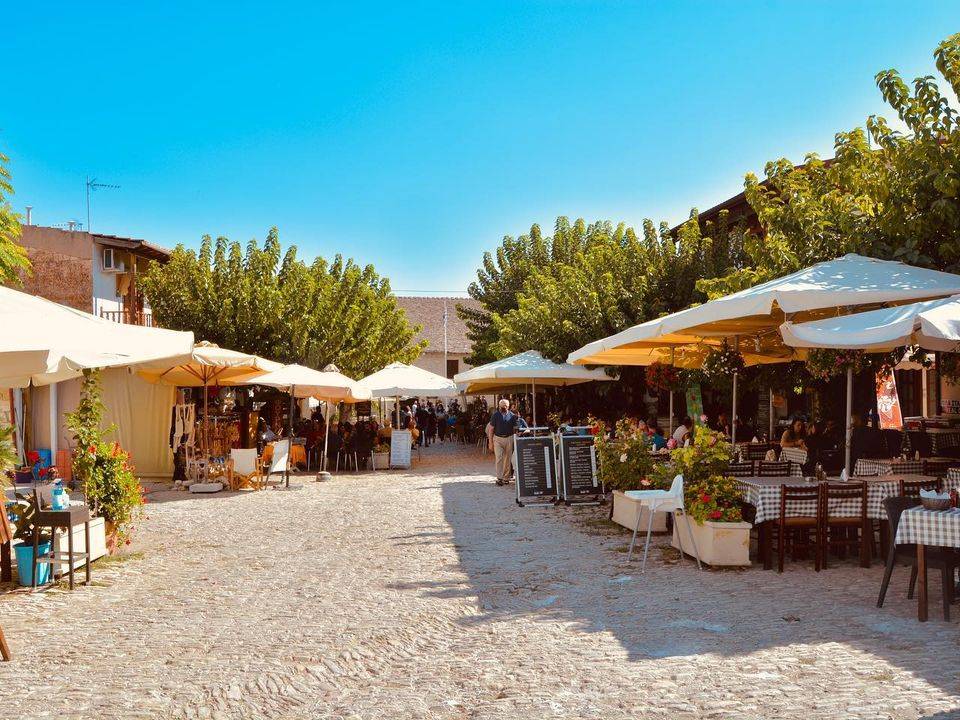The History of Omodos Village
Omodos Village sits in the Troodos Mountains of Cyprus. It is a place full of history, culture, and tradition. The village is famous for its scenic beauty, cobblestone streets, and rich heritage. Its history spans many centuries and connects to the religious, cultural, and political changes in Cyprus.
Early Origins and Development
The exact origins of Omodos are unclear. Historians believe the village dates back to the Byzantine period, around the 4th century AD. Some think it started as a small settlement near a monastery. This monastery later became the heart of the village. The area around Omodos had fertile land, making it perfect for farming. Agriculture was key to the village’s early economy.
The first written mention of Omodos comes from the Frankish period, between the 12th and 15th centuries. During this time, Cyprus was under the rule of the Lusignan dynasty. Omodos became part of the feudal system. The village was known for its vineyards and wine production, a tradition that still continues today.

The Monastery of the Holy Cross
The Monastery of the Holy Cross is one of the most important landmarks in Omodos. Local tradition says Saint Helen, the mother of Emperor Constantine the Great, founded the monastery. She visited Cyprus in the 4th century and left a piece of the Holy Cross there. This relic became the centre of the monastery.
The current building dates back to the 16th century. It was rebuilt after suffering damage from invasions and natural disasters. The Monastery of the Holy Cross became a major religious and cultural centre. Pilgrims from Cyprus and beyond visited it. The monastery also helped preserve Orthodox Christianity during periods of foreign rule, especially under the Venetians and Ottomans.
Venetian and Ottoman Periods
Omodos, like the rest of Cyprus, saw big changes during the Venetian and Ottoman periods. The Venetians took control of Cyprus in 1489 and ruled until the Ottomans conquered the island in 1571. Under the Venetians, Omodos continued to thrive as a centre for wine production. Its wine was exported to many parts of Europe.

The Ottoman period brought challenges. The Ottomans taxed the Christian population heavily, which put pressure on the villagers. Despite this, Omodos kept its cultural and religious traditions. Its location in the Troodos Mountains offered some protection from Ottoman interference, helping the village maintain its unique character.
British Rule and the 20th Century
The British took control of Cyprus in 1878. Under their rule, Omodos saw improvements in infrastructure, such as better roads and modern amenities. However, the village remained mostly agricultural, with wine production still central to its economy.
The 20th century brought more changes.

Omodos played a role in the struggle for Cypriot independence from British rule, which succeeded in 1960. After independence, many young people left the village for cities or other countries in search of better opportunities. At the same time, tourists began visiting Omodos, drawn by its history, traditional architecture, and natural beauty.
Omodos in Modern Times
Today, Omodos is a lively village that mixes its rich history with modern life. Tourists come to explore its narrow streets, visit the Monastery of the Holy Cross, and enjoy local wine and food. The village hosts cultural events throughout the year, like the “Palouze Festival,” which celebrates a traditional Cypriot dessert made from grape juice.
Despite modernization and tourism, Omodos has kept its traditional character. The village is like a living museum, where the past and present come together. Its historical buildings, including restored manor houses, museums, and churches, offer a glimpse into its fascinating history.
Conclusion
The history of Omodos Village reflects the broader history of Cyprus. From its early days in the Byzantine period to its role in modern Cyprus, Omodos has shown resilience and preserved its traditions. Today, it stands as a symbol of Cypriot heritage and the enduring spirit of its people.


